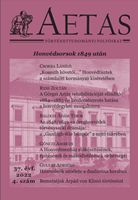Honvédnők utóélete a dualizmus korában
The Legacy of Female Soldiers in the Era of Dualism
Author(s): Adrienn GulyásSubject(s): Gender Studies, Cultural history, Military history, Political history, Social history, 19th Century
Published by: AETAS Könyv- és Lapkiadó Egyesület
Keywords: Female Soldiers; Era of Dualism; Military History;
Summary/Abstract: While it is closely related to women’s history, military history, and cultural history, the legacy of female soldiers in the Revolution of 1848-49 is still an uncharted field of research. Only two general works have been published on the topic so far: Ilona Pálffy’s Women for Hungarian Independence (Nők a magyar függetlenségért) in 1952, and Rita Szilágyi’s Women in the War of Independence (Nők a szabadságharcban) in 2012. While there are only few analytical works, significantly more biographies are available. The largest number of biographies, autobiographies and works of fiction are about the three most famous female soldiers: Mária Lebstück from Zagreb, Júlia Bányai from Vizakna, and Paulina Pfiffner from Mezőhegyes. However, the works about these three women all strongly reflect the differences in the focus of historiography in the 19th century and today, as currently the primary goal is faithfulness and verifiability, but historiographers of that time also aimed for literary qualities. These works only include sporadic footnotes in parts deemed most significant by the author, and accurate biographical details are mixed with the expectations of contemporary literature. Therefore we can conclude that due to these conventions it is difficult to assess which elements of these sources are accurate, and where did the author’s imagination take over. Furthermore, the phenomenon of the “fake female soldiers” also has to be taken into consideration. Preserving the legacy of the Revolution was one of the pillars of the political system of the era, as a constant counterpoint to the respective government. This means that contemporary monographies about 1848-49 had a political motive to exalt the heroes and heroines, sometimes done by gathering data, and sometimes by creating it. For this reason, besides the women who really participated in the battles, others are also said to have done the same, like Kázmérné Inkey, who only indirectly helped the war effort, or Janka Szentpáli and Emília Hogl, who were not involved in the fighting. Another commonly appearing character is Polish–Hungarian heroine Apollonia Jagello, who used her - according to current consensus - fake military past to become one of the most influential members of the Hungarian emigration in America. All things considered, we can conclude that the legacy of female soldiers in the era of Dualism is a multifaceted topic that involves many layers of truth, fiction, and embellished half-truths that have to be unraveled to learn the real story of female soldiers in the Revolution.
Journal: AETAS - Történettudományi folyóirat
- Issue Year: 2022
- Issue No: 4
- Page Range: 42-61
- Page Count: 20
- Language: Hungarian

